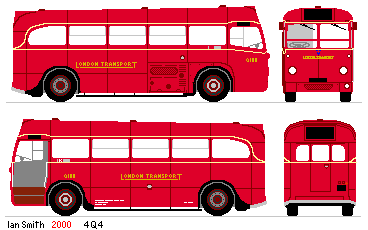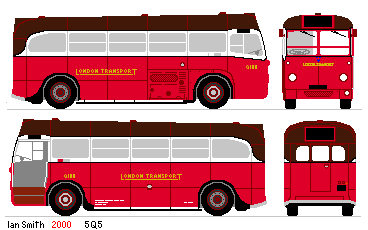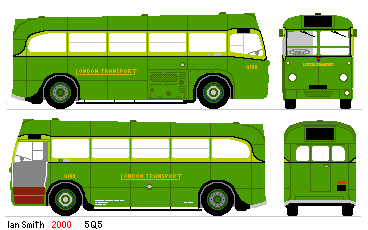
The LONDON TRANSPORT AEC Q classThis page created 1st January 2001, using Notepad, by Ian Smith.The 5Q5By 1935 the Central Area also had a requirement for new single-deckers, to replace old K and S-type single-deckers from LGOC days, plus Leyland Lions, Dennis Lancets and Dennis Es appropriated from independents. Although happy with the Regals it had inherited from LGOC, London Transport opted for Q types again. ConstructionChassis: AEC Q, 16ft 6in wheelbase, AEC A170 oil engineBody: Park Royal, 27ft 6in, B37F.
Into serviceFifty-three of the eighty 5Q5s arrived during spring 1936, and went to Dalston (D) for the 208; Merton (AL) for the 200 and 225; Chalk Farm for the 231; Old Kent Road (P) for the 202; Kingston (K) for new 255 and Harrow Weald (HD) for the 230.
Service changesAs the 1/4Q4/1s returned as coaches during 1937 they migrated again, those from Norhfleet heading to St Albans, and the Amersham contingent moving out to High Wycombe. Hatfield lost its allocation, and Watford (WA) gained some for the 311. In late 1937 the St Albans allocation for the 355 was replaced by 4Q4s, the 5Q5s going south to Dorking and Guildford for the 425.
The Central Area allocations did not remain static.
Scooters returned to the 208 in summer 1938,
so the Dalston 5Q5s moved to West Green for the extended 233.
This had been using Ts, with LTL scooters on the 241 that was absorbed.
The longer buses were not allowed through Alexandra Park,
so the scooters and 5Q5s were swapped.
The WarThe 5Q5s received wartime livery changes, with whitened corners, brown roofs, window netting and restricted lighting. Q175 was repainted grey. About half of them were converted to peripheral seating, becoming B33F, but with substantial standing room. How this was squared with the class's known bad performance relating to accidents to standing passengers and the open doorway I don't know. War overlooks all kinds of uncomfortable peacetime arguments.
Private travel restrictions during the war substantially changed people's travel patterns,
as did triple shift munitions work and women's work in manufacturing.
The 231 was double-decked in October 1939, becoming route 70,
releasing 5Q5s from Chalk Farm to Kingston for a short while.
In March 1940 they moved on to Sidcup,
where they took up residence on the 241.
Nine of the Country 5Q5s were transferred to the Central Area in 1942, three for the 208 and six for new 208A, both at Dalston. Reigate gained some for the 447 group of routes.
PostWar After the war the buses remained in demand through the bus shortages of the late forties.
The wartime livery disappeared in favour of overall red with cream lining
as the buses went through overhaul. Peripheral seating went too.
The Country Buses gradually became Central Buses,
as the latter department suffered shortages
and the Country Area received 15T13s.
All were eventually transferred, but six retained green livery until withdrawal.
Sidcup was a recipient of red and green 5Q5s,
with route 228 converting in summer 1948,
and route 241 retaining a mixture of 5Q5s and 14T12s.
After the war the buses remained in demand through the bus shortages of the late forties.
The wartime livery disappeared in favour of overall red with cream lining
as the buses went through overhaul. Peripheral seating went too.
The Country Buses gradually became Central Buses,
as the latter department suffered shortages
and the Country Area received 15T13s.
All were eventually transferred, but six retained green livery until withdrawal.
Sidcup was a recipient of red and green 5Q5s,
with route 228 converting in summer 1948,
and route 241 retaining a mixture of 5Q5s and 14T12s.
With Sidcup having 5Q5s on the 241 and the 228 it had a substantial surplus on Saturdays and Sundays, while Kingston had a large deficit on Saturday, its busiest day. So 5Q5s from Sidcup were regularly loaned to Kingston for the Saturday workings:
The endAgain, the end came suddenly in the winter of 1952-3, as the new Central Area RFs arrived. The entire class was sold to W.North of Leeds, with a few being exported for service around the Mediterranean. None is known to survive.
|
 This time they had a front entrance, with no door,
situated right at the front like the Central Area double-decker prototypes.
This pushed the front wheels backwards, reducing the wheelbase to 16ft 6in.
The floor was raised by 7.5in, making a step inside the doorway, then another into the saloon.
The sloping roof was retained, but the gutter was made parallel with the window-line.
An extra modern look was given by the wide window bays, especially on the offside,
where the run of windows was unbroken by any emergency exit. This was now in the rear of the bus,
bringing the three-window and door rear end that was to be familiar in London for forty years.
The drivers cab-side was given the modern-art treatment,
the lining sweeping round to enclose the dipping window and an enclosure for a route stencil.
Livery was spectacular: red with white window surrounds,
lined in black, with a magnificent chocolate black roof.
This time they had a front entrance, with no door,
situated right at the front like the Central Area double-decker prototypes.
This pushed the front wheels backwards, reducing the wheelbase to 16ft 6in.
The floor was raised by 7.5in, making a step inside the doorway, then another into the saloon.
The sloping roof was retained, but the gutter was made parallel with the window-line.
An extra modern look was given by the wide window bays, especially on the offside,
where the run of windows was unbroken by any emergency exit. This was now in the rear of the bus,
bringing the three-window and door rear end that was to be familiar in London for forty years.
The drivers cab-side was given the modern-art treatment,
the lining sweeping round to enclose the dipping window and an enclosure for a route stencil.
Livery was spectacular: red with white window surrounds,
lined in black, with a magnificent chocolate black roof.
 Meanwhile the Country Area was considering the conversion of twenty seven 4Q4s to
Greenline service, and would need to replace them. So Q152,
which had been used as a mechanical trainer before bodying,
and another twenty-six were finished in green livery for delivery during July and August 1936.
They went initially to Northfleet (NF) - six;
Hatfield (HF) - four;
Hertford (HG) - eight;
Amersham (MA)- five;
High Wycombe (HE) - three;
and Reigate (RG) -one.
Meanwhile the Country Area was considering the conversion of twenty seven 4Q4s to
Greenline service, and would need to replace them. So Q152,
which had been used as a mechanical trainer before bodying,
and another twenty-six were finished in green livery for delivery during July and August 1936.
They went initially to Northfleet (NF) - six;
Hatfield (HF) - four;
Hertford (HG) - eight;
Amersham (MA)- five;
High Wycombe (HE) - three;
and Reigate (RG) -one.
 bus histories
bus histories Bus Stop
Bus Stop Q index.
Q index. 4Q4
4Q4 5Q6
5Q6